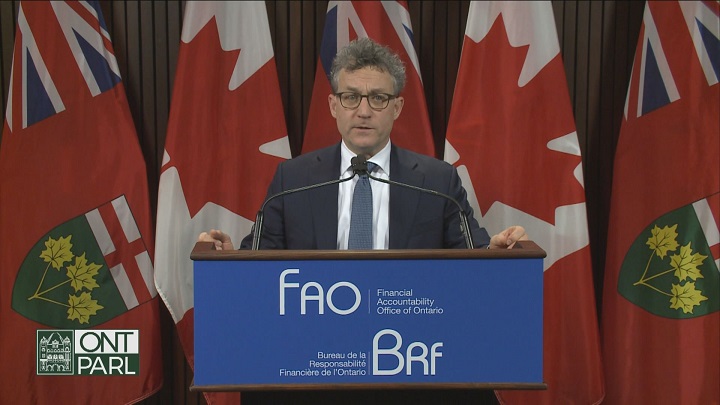TORONTO – There is a “significant risk” that the Progressive Conservative government’s spending plan will fall $5 billion short of what’s needed for health and education in the coming years, Ontario’s budget watchdog said Monday.

Financial Accountability Officer Peter Weltman released an economic outlook and budget report saying the need for those services will far exceed what’s in the government’s fiscal plan by 2021-22.
A growing and aging population in Ontario over the next several years will place additional demands on the health-care system, Weltman said, and consumer prices are expected to rise by 6.2 per cent, adding more cost pressures.
Taking that into account, program spending would have to rise by $11.4 billion more by 2021-22 than the government is planning in order to maintain the current mix and quality of Ontario’s public services, Weltman said.
The government has introduced many cost-cutting program and policy changes over the past 18 months, which the FAO estimates will save $6.6 billion. But that still leaves the province $4.8 billion short, he said.
“There is a significant risk that the fiscal plan will not provide sufficient resources to meet future ongoing demand for key public services,” Weltman said.
If the government doesn’t plan to boost spending by $5 billion, it could make additional cuts, look for more efficiencies in the delivery of public services, or underfund current programs, he said.
Finance Minister Rod Phillips said the government is balancing three priorities.
“We have been balancing putting money back into people’s pockets, we’re also balancing our objective of making sure the province is on a sound financial footing and investing more in critical services – healthcare and education,” Phillips said.
He noted that the government increased spending on health and education this year, but hospital funding came in well under what those institutions said was needed to maintain staffing levels. And though the overall dollar figure in education is up, per-pupil funding is down and teacher jobs are being eliminated through class-size increases.
New Democrat Peter Tabuns called Weltman’s warning “the tip of the iceberg.”
“It’s clear from the FAO that this government is setting up cuts in education and public health services in order to stabilize their financial approach, and we are all going to get hit,” he said.

Weltman also said the government could balance the budget by 2021-22, instead of its target of 2023-24, if it doesn’t implement tax cuts and additional spending that were promised during the election.
The government’s plan hinges on limiting spending growth so it can make tax cuts and still balance the budget by its target, Weltman said. If the government achieves its spending plan, program spending would be reduced by $1,070 per person.
Green party Leader Mike Schreiner said Ontario already has some of the lowest per-capita health spending in the country.
“The government’s fiscal plan hinges entirely on cuts to public services that will only worsen the state of our health care, education and social services,” he said.
“We cannot cut our way to prosperity.”



Comments